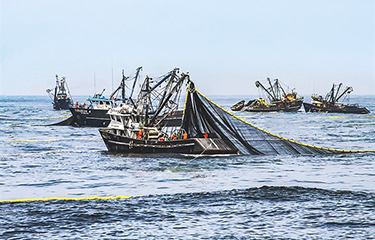Peru is expected to surpass USD 2 billion (EUR 2 billion) this year in earnings from exports of fishmeal and fish oil, compared to USD 2.3 billion (EUR 2.3 billion) in 2021 – which was up 60 percent from 2020.
The earnings total was first reported by Peruvian government news service Andina, citing figures from Peru’s National Fisheries Society (SNP).
“There is a growing demand for feed, mainly for poultry farming, [whereby] countries’ consumption in fishmeal and fish oil increases and therefore demand increases for higher-quality protein products, driving prices upward,” said Eduardo Scerpella, president of Pacific Control, a consultancy on regulation, technical barriers to trade, and quality control.
According to figures from the Central Reserve Bank of Peru (BCR), the price of fishmeal stood at USD 1,435 (EUR 1,445) per metric ton (MT) in 2019, USD 1,369 (EUR 1,379) in 2020, and USD 1,494 (EUR 1,505) in 2021. The country’s anchovy fishery, which targets both Engraulis ringens and Anchoa nasus primarily for use in making fishmeal and fish oil, is the largest by volume in the world.
Peru caught 5.1 million MT of anchovy in 2021. Thus far in 2022, Peru's total anchoveta landings are at 2.34 million MT – or 84.06 percent of the total allowable catch (TAC). The beginning of the second season for Peru's north-central region, the world’s largest anchovy fishery, is expected to be announced soon. Peru divides its anchovy fishing areas into two regions – south and north-central – with different capture limits and seasons set for each. The north-central is Peru’s main fishing region, with capture measuring several times that of the south region.
In July, PRODUCE opened the second anchovy fishing season of the year in the country's south region, setting a TAC of 486,500 MT. That season is slated to run through December, or until the TAC is reached, whichever comes first. Any fishing season may also be modified according to biological-environmental conditions, based on findings from the Peruvian Sea Institute (Imarpe) – a technical agency within PRODUCE that advises the state on marine conservation issues and that performs studies to evaluate the status of the Peruvian anchovy biomass.
“Countries are aware that the ecosystem must be maintained and sector players have self-imposed controls and systems that allow biomass to be conserved over time, which means that the offer of this product is stable but increasingly of greater value, which is precisely where the industry is currently investing in providing greater added value to the product,” Scerpella said.
However, the increase in value of fishmeal has brought unwanted attention from within the country and from neighbors. According to a study by nonprofit group Oceana, in 2019 alone, some 150,000 MT of Peruvian anchovies were caught illegally and sent to fishmeal-processing facilities. In neighboring Ecuador, according to Mongabay, between late 2020 and early 2022, Peruvian authorities issued 44 alerts of unauthorized industrial fishing in the protected Pacific Ocean marine reserve Cantagallo-Machalilla, located off the coast of Manabí province.
Most of those vessels were fishing for smaller fish such as anchovies or sardines, which would then be used for the production of fishmeal, news service InSight Crime reported, adding that the U.S. International Trade Commission estimates that 9 percent of all fishmeal in the United States is obtained from illegal catches. Besides decimating the biomass itself, overfishing the smaller fish can have a domino effect in the maritime food chain, removing a key food source of larger species, the U.S. ITC said.
"One of the improvements that must be worked on in the process of certifications and controls required by Peruvian companies for the export of fishmeal and fish oil is the systematization of the entire production chain, so that the traceability of the product can be seen in real-time,” Scerpella said. “Fishmeal-producing companies that do not have certifications cannot serve the international market, so their supply is limited to the local market.”
Scerpella said the main objective of the certifications is to guarantee the control and quality of fishmeal in order to obtain a safe product with a high nutritional value. Critical factors in quality control include the freshness of the raw material, temperatures to which the material is exposed during processing, stability of the oils, and hygiene.
Photo courtesy of PRODUCE







